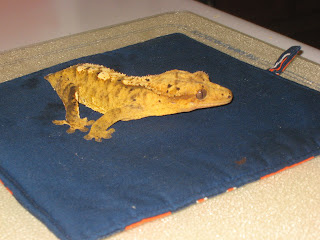We tried to handle the lizard only every few days at this point so he’d have a chance to adjust to his new environment. The breeder suggested we let him walk on our hands by moving one hand in front of the other. We found he was very jumpy and could quickly move from hand to arm to shirt. It’s a little freaky at first, but he never tried to bite and we were very gentle with him. There was no need to touch his tail since I could kind of peel him off by carefully cupping my hand over his body.
After about three months, we were getting more confident with him and he was getting used to our periodic handling. One evening when I went to get him out, my eyes fell upon a lone tail lying in the open on a log. It took a second to register that this three inch span of lizard was not attached to a body. “No!” I spouted. “No, no, no, nooooooo.” Picture the scene from Toy Story, near the end when Woody’s match goes out just as he’s about to light the rocket. That was me.
I immediately pointed an accusatory finger, but as usual, “nobody knew nothin.” This time I actually believed them, but was very upset knowing a mistake was made and there was no fixing it. The gecko appeared fine. There was a little pointed stump in the place where his tail would have attached, but it was clean and already healing.
I deduced that the cage position on top of our son’s dresser was probably to blame. Whenever said son would open or close a drawer, the dresser would shake or wobble a little. I think this was enough to jiggle one of the log pieces out of place and the little guy’s tail must have been caught under one. I hadn't been able to locate him the night before and decided to just let him be. I’m guessing he was probably pinned under a log and had to finally pull away when thirst or hunger got the best of him.
I stayed in a disappointed state for a couple days, but felt a little better after reading that 75 percent of crested geckos studied in the wild were observed without tails. I told myself and the kids it was probably best he lost the tail now rather than a year or two from now when it would have been even more traumatizing, to us that is. My self-soothing philosophy said, “That’s out of the way now and we don’t have to worry about it.”
That was over a year ago and there’ve been no problems since. I moved the cage to our bird room where there's special lighting and more appropriate temperatures. The stump never bled or swelled or anything and frankly, the gecko didn’t seem to miss it. That’s a wild animal for you: They don’t dwell on things the way we humans do. Even our domesticated pets still have natural instincts on which they rely. We have much to learn from these creatures with whom we choose to surround ourselves.
Young crested gecko before losing tail. Photo without tail coming soon.
Here's a photo of our crested gecko at nearly two years of age. She's about 4 to 5 inches long without the tail. She's resting on a pot holder, though she doesn't stay still for very long when she's out of her vivarium.


I can only imagine how frustrating it must have been to do everything in your power to ensure you protected his tail and kept him whole.
ReplyDeleteI enjoyed reading your post about your crested gecko!